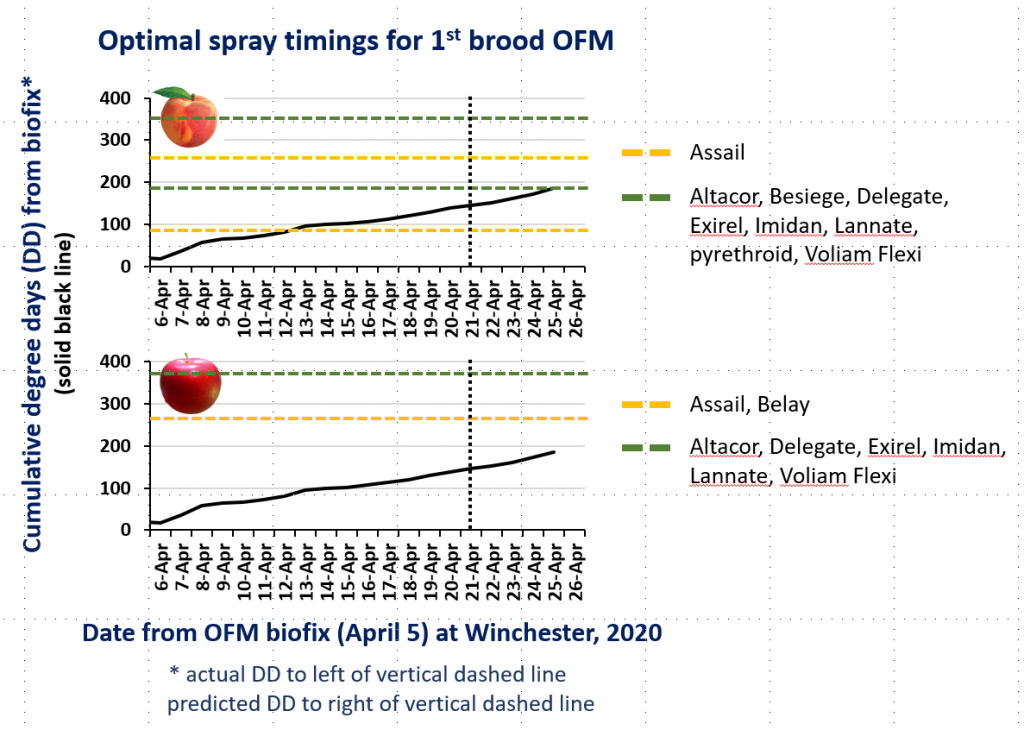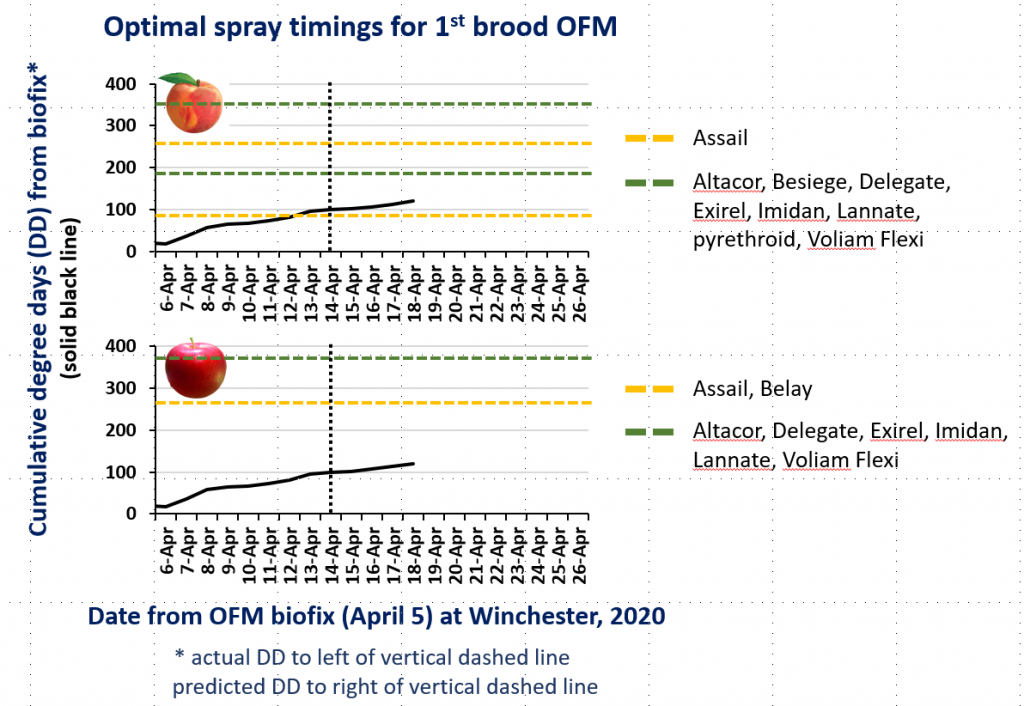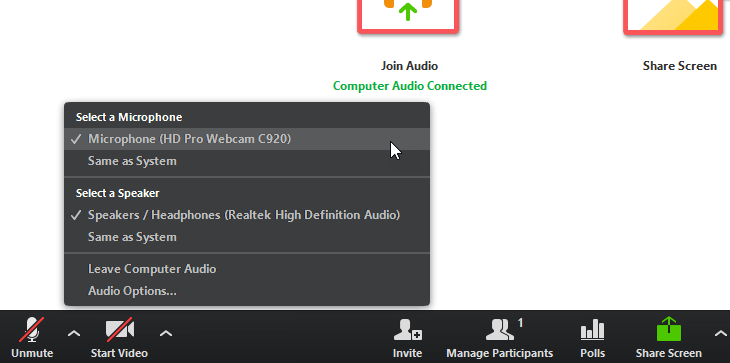No captures of codling moth at the Winchester AREC as of Monday, April 20.

Greetings, This year I’m going to try a new way to present degree day (DD) accumulations from biofix and optimal spray timing recommendations for various insecticides for OFM and codling moth (CM). As I noted last week, OFM biofix was set at Winchester on April 5. The solid black line in the graphs below shows how many DD already have and are predicted to accumulate for OFM since biofix (see footnote). The colored horizontal lines are recommended optimal timings for the color-coded products shown to the right of the graphs. These recommended optimal timings are based on the relationship between DD accumulations and the percentage of eggs of each brood that have hatched (here the 1st brood of OFM). Note that recommended timings amd number of sprays for 1st brood OFM differ between apple and peach. The vertical dashed black line separates actual DD accumulations (to left of line) and 5-day predicted accumulations (to right of line), based on output from Cornell’s NEWA system using temperature data from the weather station at the Winchester AREC. When the solid black line crosses one of the colored lines, the date on the horizontal axis below is the optimal date to apply the product corresponding to that color. So, for Assail in peaches, the best timing would have been April 12th or 13th. As the solid black line approaches the intersection with one of the colored lines, this will give you advanced notice that an optimal spray timing is approaching. Of course, the decision to apply an insecticide can also be informed by moth captures in pheromone traps. For 1st brood OFM in peaches the threshold is an average of more than 15 moths/trap/week and in apples is more than 30 moths/trap/week. Once we are into 2nd brood OFM, the threshold is more than 10 moths/trap/week for both crops. We have not captured CM in our traps at the AREC, but will include a similar graph for it once biofix has been set.

I’m calling biofix for OFM in the Winchester area for Sunday, April 5, based on sustained captures since then, although at relatively low levels. We will soon begin to post regular updates regarding degree day accumulations from OFM biofix and spray timing/product selection implications on my section of the website at https://blogs.ext.vt.edu/tree-fruit-pest/. If you plan to use mating disruption for OFM, now would be a good time. Recall that OFM is one of the species that shows “protandry”, which means that males emerge before females. The degree day models that we run are to predict egg hatch; therefore, females need to be present for mating and egg-laying to occur. Given the cool and windy conditions forecast for many of the next 10 days, I don’t expect a heavy , sustained flight of OFM until the weather improves. The sprayable formulation for OFM (CheckMate OFM-F) is a good choice for managing first generation OFM and to mitigate its populations from increasing during the season. This product is applied at 1.32 – 2.93 fl oz/acre, but is not especially rainfast, so may need to be reapplied to cover the flight of the entire first generation if heavy rain occurs after application. Sprayable pheromone is intended to be applied against each generation of OFM. Other options for OFM mating disruption include a number of hand-placed pheromone dispensers from Trece (Cidetrak products; trece.com/products/) and Pacific Biocontrol (Isomate products; pacificbiocontrol.com/details/), which provide extended control. Both companies also provide dual species mating disruption dispensers for codling moth and OFM, which are typically applied in apples during bloom. Of course peaches are now at petal fall, and so also need protection from a number of other pests from this point forward, including plum curculio, tarnished plant bug, and stink bugs, among others. In the Spray Bulletin, we recommend a broad spectrum pesticide at petal fall, including one of the pyrethroids, Lannate, or Imidan. Follow-up applications at shuck split and shuck fall could also include a pyrethroid, or a range of others listed in the Bulletin, according to which pest(s) were most problematic last year (i.e. some of the products listed for shuck split and shuck fall are narrower in their spectrum of activity).
Greetings, For our weekly meetings via Zoom (Tuesdays starting at 12 PM) we would like to invite you to submit digital photos of things you are seeing in your orchards this year that you have questions about. Along with our updates, we could discuss these pictures together and try to provide relevant feedback and recommendations. This could include pictures of disease, insects or insect injury, or horticultural issues. It would be very useful if you would also send us photos of the stage of fruit bud development in your area. When you submit photos of any issues you are seeing (i.e. other than stage of bud development), please include any pertinent information and your specific question(s). We will keep these photos anonymous, but read your question/comments about each image to the group. Of course, sharp and clear images will work best for this, and it would be ideal to receive them by about 11 AM on Tuesday. You can send these as attachments to any or all of us at the following addresses: cbergh@vt.edu, ssherif@vt.edu, ksyoder@vt.edu, or mastuph2@vt.edu. Looking forward to meeting with you again this Tuesday.
Greetings, We captured one oriental fruit moth (OFM) in each of two traps here at the Winchester AREC on Sunday night and one in the third trap on Monday night (i.e. OFM flight in this area has begun, although at a trickle). As we have discussed before, biofix is determined when sustained flight and captures of moths over several consecutive days has occurred. Setting biofix for OFM is usually a bit of a judgement call, because captures tend start and stop repeatedly based on daily weather variations at this time of the season. The weather forecast for Winchester shows a maximum temperature of 59 F or lower through Friday, and I wouldn’t be surprised if few or no additional moths are captured until the weekend. In central Virginia, a grower reported that he caught a total of 4 OFM between Mar 27 and 29, and is calling biofix for Mar 27. The weather in central Virginia is due to warm more quickly than Winchester, and daily temperatures there at 63 F or higher starting on Thursday will likely result in more sustained OFM flight. So, the take-home message is that if you are in central Virginia and have OFM sprayable pheromone in your plan for first generation control, application in the coming days would be good. If you are in the region including Winchester, it’s a bit premature to apply OFM sprayable pheromone, but I will keep you posted regarding our captures here.
Greetings, In view of the fact that we can’t hold in-person Extension meetings until further notice, we’d like to add a new feature to our programming to fill that gap as best we can. Starting this Tuesday, March 31, we will hold meetings each Tuesday from 12 – 1 PM via the Zoom video-conferencing software. Dr. Sherif, myself, and perhaps Drs. Yoder and Pfeiffer (as available) will provide seasonal updates, take questions, and facilitate conversation among you. Zoom has become a widely adopted way to hold video-conferences and is quite easy to use after you’ve done it once or twice. You can participate via your PC or laptop, using the link provided at the bottom of this post, or you can call in using the telephone number provided. Many laptops have a built-in camera, enabling you to see us and vice versa. Some, but not all PCs also have a camera, but others (like mine) have a camera installed as a separate device. While a camera is nice, it is not necessary. Most importantly, your PC or laptop computer should have a built-in microphone to enable conversation among us, which most do. If not, as I mentioned before, you can call in via phone. Zoom is a free download, so if you wish to join these meetings using your computer, it would be good to install that in advance. Otherwise, you will be prompted to do so when you click the “Join” link at the end of this message. Our IT person here has provided guidance (below) to help facilitate this for you. The advantage of joining via computer is that you will be able to see anything that we share on the screen, including Powerpoint slides, pictures, etc. We hope this will be a useful tool that will enable us to work together as this season progresses and that you will join us for some or all of these. There will undoubtedly be a learning curve as we make this happen, but learning new tools is never a bad thing. Again, at the bottom of this post is the link for joining this first meeting. I will also ask your Extension agents to distribute the invitation by e-mail. Stay tuned.
How Do I Join a Meeting?
Joining Conference Audio and Video
https://support.zoom.us/hc/en-us/articles/201362283-How-Do-I-Join-or-Test-My-Computer-Device-Audio-

Chris Bergh is inviting you to a scheduled Zoom meeting.
Join Zoom Meeting
https://virginiatech.zoom.us/j/999000793
Meeting ID: 999 000 793
One tap mobile
+19294362866,,999000793# US (New York)
+13126266799,,999000793# US (Chicago)
Dial by your location
+1 929 436 2866 US (New York)
+1 312 626 6799 US (Chicago)
+1 669 900 6833 US (San Jose)
+1 253 215 8782 US
+1 301 715 8592 US
+1 346 248 7799 US (Houston)
Meeting ID: 999 000 793
Find your local number: https://virginiatech.zoom.us/u/acHdeF3H7e
Greetings, I hope this finds everyone safe and sane during these troubled and uncertain times. As you know, we have had to suspend our in-person Extension programming until further notice, so will try to provide relevant content via posts like this. We have had pheromone traps for oriental fruit moth (OFM) deployed in our orchards here at the Winchester AREC for 1 week, but no captures yet, despite full bloom of Redhaven peaches on March 23. This got me wondering about how OFM biofix (the onset of sustained flight and captures in the Spring) has related to full bloom in peaches over the years. In general, they tend to occur reasonably close together, but I’m interested in the question, “how close together”? The reason this is relevant is that one strong option for managing first generation OFM in peaches is mating disruption, whether by the sprayable pheromone or hand-placed dispensers (both of which can be applied during peach bloom). I compared the dates of OFM biofix and full bloom of Redhaven peaches at this AREC over 17 years spanning 2001 – 2019, looking at whether biofix occurred before, during, or after full bloom. Turns out that the average difference in days between those two events was zero. On other words, the average OFM biofix date occurred on the recorded date of Redhaven full bloom. Having said that, the range was from -11 days (i.e. biofix before full bloom) to +12 days (i.e. biofix after full bloom). Of the 10 years between 2001 and 2010, there were 4 years when biofix occurred before full bloom, 4 years when biofix and full bloom occurred on the same date, and only 2 years when biofix occurred after full bloom. Interestingly, in the 8 years between 2011 and 2020 (no bloom data for 2017 and 2018), there has been only 1 year when biofix occurred before full bloom, 1 year when they occurred on the same date, and 6 years when biofix occurred after full bloom (including this year). This makes me wonder whether the generally milder winters we have experienced in recent times have had a greater effect on tree development rate than OFM development rate, but of course that is pure speculation. Anyway, the take-home message is that mating disruption for OFM is not yet required here in the northern Virginia region. Of course tree and pest development typically happen more quickly in central and southern Virginia than they do here in Winchester. Pheromone traps provide a very sensitive indication of the beginning of OFM flight (and also of other key pests, like codling moth) and can guide your timing of mating disruption applications. I will keep you posted about our OFM captures, which would not be expected until the weather warms considerably compared with today. We will put our codling moth traps our in March and also keep you posted about captures in those.
Until next time, best wishes.
Greetings,
As of today, July 13, the NEWA weather system shows that 2138 DD (degree days) have accumulated for oriental fruit moth (OFM) at Winchester. We are now in the third generation of OFM and optimal timings in peaches for this brood are as follows: Assail or Intrepid at 2000-2100 DD, then at 2350-2400 DD; all other insecticides at 2100-2200 DD, then at 2450-2500 DD. In apples, optimal timing for third brood OFM is as follows: Rimon at 2300-2350 DD; Assail, Belay or Intrepid at 2350-2400 DD, then at 2800-2900 DD; all other insecticides at 2450-2500 DD, then at 2900-3000 DD. OFM management is warranted if weekly captures in pheromone traps have exceeded an average of 10 moths/trap. The daily forecast for OFM DD from July 14 – 18 is as follows: 2170, 2203, 2239, 2276, and 2312.
For codling moth, management of the second half of second generation is approaching if weekly captures in pheromone traps have exceeded an average of 5 moths/trap. As of today, July 13, 1513 DD have accumulated for CM at Winchester. Optimal timings for CM at this point in the season are as follows: Rimon at 1650 DD; Assail, Belay, CM virus, Esteem, or Intrepid at 1650-1700 DD; all other insecticides at 1750-1800 DD. The daily forecast for CM DD from July 14 – 18 is as follows: 1540, 1568, 1599, 1631, and 1662.
Until next time, best wishes.
Greetings,
The time for managing second brood codling moth (CM) larvae is rapidly approaching. As of today (July 2), 1216 DD have accumulated for CM at Winchester and the NEWA system forecasts the following for it: 1246 DD on July 3, 1276 DD on July 4, 1304 DD on July 5, 1334 DD on July 6, and 1360 DD on July 7. Optimal timing for the first spray against this brood of CM is as follows: Rimon at 1250-1320 DD, Assail, Belay, CM virus, or Esteem at 1350 DD, and all others at 1450 DD.
Third brood oriental fruit moth (OFM) would be targeted in peach starting at 2000-2100 DD if using Assail, while all other products recommended for this pest would be best applied at 2100-2200 DD. The NEWA system forecasts 1955 DD for OFM on July 7. In apple, optimal timing for third brood OFM begins at 2350 DD.
Until next time, best wishes.